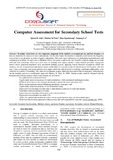Computer assessment for secondary school texts

View/
Date
2013-12Author
Sello, Q.M.
Totev, D.M.
Kgosiemang, R.
Liu, Y.
Publisher
IJACT, http://ijact.in/ijact/Type
Published ArticleMetadata
Show full item recordAbstract
Secondary school tests are very important component of the student’s assessment process and their frequency is directly related to the success of year examinations. On the other hand, the number of students could restrict the frequency of tests that is not desirable in terms of quality educations. Obviously such a dilemma is a challenging methodological and technological problem. In such cases a Multiple Choice test paper could be the only feasible solution, taking into account staff and time constraints. There are a few ways of marking such papers, mainly: a fully manual procedure with preset answer sheets (punched templates); fully automated marking process, applying optical character recognition (OCR) and scanners; the use of special pens and answer sheets could reduce to a certain extent the human factor involvement. The first case is time consuming, error prone and the stress under which the staff involved is working, contributes additionally to the relatively low quality of marking. The other two techniques require additional investment and technological infrastructure, but the marking process is significantly improved (Mogey, N. Watt, H. 2009). Similar results could be obtained with the demonstrated software project, whose main features are as follows:
- No additional investment involved.
- Significantly improved accuracy of mark calculations – fully automated marking procedure.
- Reduced stress factor – the computer keyboard is used in the most convenient way.
- Better synchronization between Marking and Quality Assurance staff.
- Significantly improved accuracy of the moderated scripts.
- Improved record keeping of grades that is individualized and easy to track and manage.
- Immediate statistical analysis of results.
- Improved record keeping with respect to the school archives.
- Registered error tolerance less than 1.5%.
- Ability for marked and moderated work to be accessed based on users pre-determined rights.
- Multi-level hierarchical approach to data security and staff responsibility structure (www.tcexam.com, 2009).
